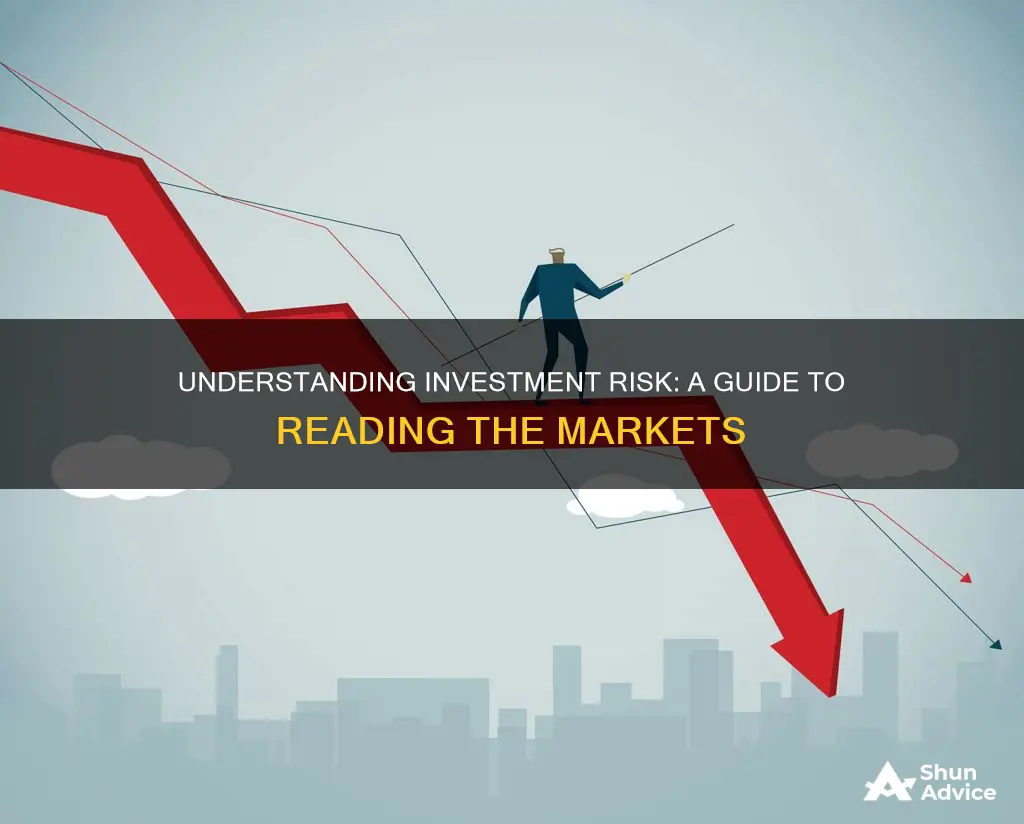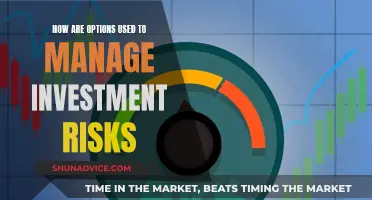
Risk is an inherent part of investing, and understanding the different types of risks is crucial for making informed investment decisions. Investing involves buying securities or assets with the hope of generating returns, but it's important to recognise that the potential for higher returns comes with higher risks. This relationship between risk and return needs to be carefully considered to avoid taking on more risk than one is comfortable with or losing money.
There are various types of investment risks, including horizon risk, concentration risk, market risk, liquidity risk, credit risk, and longevity risk, each with its own unique characteristics and potential impact on an investment portfolio.
By gaining a comprehensive understanding of these risks and employing tools such as diversification, asset allocation, and statistical measures, investors can make more informed decisions, potentially increasing returns and reducing the risk of losses.
What You'll Learn

Understanding your risk profile
Your risk profile is influenced by various factors, including your age, income, financial goals, emotional response to market fluctuations, and investment time horizon. For example, a young investor with fewer responsibilities may be willing to take on more risk than a middle-aged investor. Similarly, an investor with a longer investment time horizon, such as saving for retirement, may be able to tolerate more risk than someone with shorter-term financial goals, like saving for a down payment on a house.
It's important to note that your risk profile is not static and can change over time as your financial circumstances, goals, and life situation evolve. Therefore, it is recommended to periodically reassess your risk profile to ensure that your investment strategy remains aligned with your needs and goals.
To determine your risk profile, you can ask yourself several questions, including:
- What are your specific investment goals?
- How often do you plan to check your investments, and is it due to nervousness about volatility?
- Is your portfolio diversified across different assets, commodities, vehicles, or companies?
- What is your emotional response to market volatility and potential losses?
By understanding your risk profile, you can make investment decisions that align with your comfort level and help you progress toward your financial goals.
Equity Group Investments: What's Their Focus?
You may want to see also

Risk tolerance vs risk capacity
When it comes to financial planning and investment decisions, two key concepts that are often used interchangeably but have distinct meanings are risk tolerance and risk capacity. Both are crucial in crafting a balanced, effective investment strategy.
Risk Tolerance
Risk tolerance refers to an individual's psychological willingness to take on risk. It is about emotional and psychological comfort with risk. Risk tolerance is subjective and varies from person to person, influenced by factors like age, gender, income, personality, past experiences, and various behavioural biases. It can also change due to life events, age, and economic conditions.
For example, a young investor with a high-risk tolerance may be comfortable with the ups and downs of the stock market, chasing higher long-term gains, and seeing volatility as an exciting opportunity. On the other hand, an investor with a lower risk tolerance may get anxious about losing money and want to preserve their capital, opting for more conservative investments.
Risk Capacity
Risk capacity, on the other hand, relates to the financial ability to endure potential losses. It is a quantitative and objective measure of how much risk an individual can take on without jeopardising their financial stability or goals. It is determined by concrete financial circumstances like income, assets, liabilities, debts, insurance coverage, dependents, and time horizon.
For instance, an investor with a high-risk capacity may have a sizable investment portfolio, a stable high income, limited debt, and adequate insurance coverage. They can afford to take on more risk as they have the financial ability to absorb potential losses. Conversely, an investor with a lower risk capacity may have limited savings, a fixed modest income, several dependents, and a shorter time horizon, making them less able to endure significant losses.
Balancing Risk Tolerance and Risk Capacity
It is important to achieve harmony between risk tolerance and risk capacity to ensure a sustainable and fruitful investment journey. This involves understanding one's risk profile, which can be grouped into conservative, moderate, and aggressive categories. A balanced portfolio should respect both the investor's emotional comfort and financial reality, involving a mix of assets that align with their risk tolerance and capacity.
While risk tolerance and risk capacity are distinct concepts, they are not always the same for an individual. This discord can lead to investment strategies that may either be too stressful for the investor or expose them to financial peril. Thus, it is crucial to regularly review and adjust one's financial plan and investment strategy to maintain a balance between risk tolerance and risk capacity.
Understanding When to Hire an Investment Manager
You may want to see also

Systematic and unsystematic risk
Systematic Risk
Systematic risk, also known as market risk, is the uncertainty that affects many investments. It is caused by macroeconomic factors beyond the control of investors, such as inflation, exchange rates, political instability, and natural disasters. Systematic risk is inherent in the market and cannot be diversified away. It impacts the entire asset class or the market as a whole.
Types of systematic risks include:
- Interest rate risk: Results from changes in market interest rates, impacting fixed-income securities like bonds.
- Market risk: Arises from investor behaviour during financial crises, leading to avoidance of investments even in well-performing companies.
- Purchasing power risk/Inflation risk: Occurs when inflation erodes the purchasing power of money.
Unsystematic Risk
Unsystematic risk, also known as nonsystematic or specific risk, is unique to a particular company, industry, or investment. It arises from internal and external factors affecting a specific organization or industry. Unsystematic risk can be mitigated through diversification strategies.
Types of unsystematic risks include:
- Business risk: Includes internal factors affecting a company's revenue and performance, as well as external factors such as government regulations banning certain raw materials.
- Financial risk: Relates to a company's debt and equity structure, with too much debt leading to a negative debt-to-equity ratio and potential bankruptcy.
- Operational risk: Results from unforeseen events like supply chain disruptions, manufacturing errors, or security breaches.
- Strategic risk: Occurs when a company fails to adapt to changing industry dynamics, such as the shift to electronic cars.
- Legal and regulatory risk: The risk of changes in laws or regulations increasing operational costs, introducing legal hurdles, or even halting business operations.
Impact and Mitigation
Systematic risks can potentially affect entire industries and the overall economy, while unsystematic risks generally impact individual organizations. Systematic risks are uncontrollable and unavoidable, whereas unsystematic risks can be controlled, avoided, or mitigated.
To protect against systematic risk, investors can focus on proper asset allocation, while unsystematic risk can be addressed through portfolio diversification.
Calculation and Measurement
The systematic risk of a security, fund, or portfolio can be measured using its beta coefficient, which indicates the sensitivity of its return relative to the market.
Unsystematic risk, on the other hand, can be calculated by subtracting systematic variance from total variance or by using the formula: Unsystematic risk = Total variance - Systematic risk.
Smart Investing Guide: 40 Lakh Strategies for Indians
You may want to see also

Diversifying your portfolio
Spread the Wealth
Diversification is about not putting all your eggs in one basket. It's important to spread your investments across different industries, sectors, and asset classes. Consider investing in a range of companies of varying sizes and in different sectors, such as technology, healthcare, energy, and financials. By diversifying across industries and sectors, you reduce the risk associated with having all your investments in one area, which may be susceptible to industry-specific risks.
Diversify Across Asset Classes
Invest in multiple asset classes, such as stocks, bonds, cash and cash equivalents, real estate, and commodities. Each asset class tends to generate different returns and is subject to varying levels of risk. By diversifying across asset classes, you reduce the impact of any single investment or market segment on your portfolio's performance.
Diversify Within Asset Classes
Further diversification can be achieved by exploring different options within each asset class. For example, if you invest in stocks, consider a mix of large-cap, mid-cap, and small-cap companies. In terms of bonds, look for different maturities and issuers, including government and corporate bonds.
Diversify by Location
Global diversification is another important aspect. Investing solely in domestic securities exposes your portfolio to country-specific risks. By including foreign stocks and bonds from developed and emerging markets, you can benefit from the performance of global markets, which may move independently of your home market.
Explore Alternative Investments
Consider adding alternative investments such as Real Estate Investment Trusts (REITs) and commodities to your portfolio. These assets are not strongly correlated with traditional stocks or bonds and can provide further diversification.
Regularly Rebalance Your Portfolio
Even with an initially well-diversified portfolio, market movements and changing circumstances can cause your asset allocation to drift over time. Therefore, it's important to periodically rebalance your portfolio to maintain your intended asset allocation and risk profile.
Remember, diversification does not guarantee returns or protect against all losses. It is a strategy to help manage risk and improve long-term investment performance. The specific investments and asset allocation within your diversified portfolio should be based on your risk tolerance, time horizon, and financial goals.
Big vs Small: Equity Investment House Rules
You may want to see also

Using statistical measures
Statistical methods based on historical data are used to measure investment risk. These methods can range from simple to complex, with each offering unique insights. Below are some of the most common statistical measures used to assess investment risk:
- Alpha: Measures the performance of an investment portfolio and compares it to a benchmark index. It is a way of calculating "excess return" – the portion of investment performance that exceeds the expectations set by the market.
- Beta: Measures the volatility or systematic risk of a fund in comparison to the market or a selected benchmark index. A beta of one indicates the fund is expected to move in conjunction with the benchmark. Betas below one are considered less volatile, while those over one are considered more volatile.
- R-squared: Quantifies how much of a fund's performance can be attributed to the performance of a benchmark index. It represents the correlation between the examined investment and its associated benchmark.
- Standard Deviation: Measures data dispersion in regards to the mean value of the dataset and provides a measurement of an investment's volatility. In the context of investments, it measures how much the return on investment deviates from the expected normal or average returns.
- Sharpe Ratio: Measures performance adjusted by the associated risks. This is done by removing the rate of return on a risk-free investment and dividing it by the associated investment's standard deviation. It indicates whether an investment's return is due to wise investing or the assumption of excess risk.
- Value at Risk (VaR): A statistical measure of the potential loss in value of a risky asset or portfolio in a given period for a given confidence interval. It provides a single, easy-to-understand number that encapsulates the downside risk of an investment.
- Conditional Value at Risk (CVaR): Also known as the expected shortfall, CVaR addresses some of the limitations of VaR by measuring the expected loss if the loss is greater than the VaR.
These statistical measures can be used individually or in combination to assess investment risk and make more informed investment decisions.
Private Equity's Impact on Healthcare: Patient Investment
You may want to see also
Frequently asked questions
Investment risk is the chance that an investment decision will result in losing some or all of the money invested.
There are two main types of investment risk: systematic and unsystematic risk. Systematic risk, or market risk, refers to factors that can affect the entire financial market or a whole market segment, such as economic conditions, political changes, health crises, and natural disasters. Unsystematic risk is more concentrated and affects a specific company or industry, such as a company going bankrupt or regulatory changes impacting a particular market segment. Other types of investment risks include business risk, liquidity risk, credit risk, interest rate risk, inflation risk, and political risk.
Risk tolerance refers to the level of psychological comfort an individual has with financial risk, while risk capacity is the amount of risk that can be reasonably taken based on practical conditions. Factors influencing risk tolerance include disposition, age, economic status, and life events. Risk capacity, on the other hand, is determined by objective factors such as age, family status, income, debt level, and job stability. It's important to consider both risk tolerance and risk capacity when developing an investment strategy.
Risk can impact your investment portfolio in several ways. It can lead to a decline in the value of your investments or even a complete loss of your investment. Different types of risks, such as market risk, concentration risk, equity risk, interest rate risk, currency risk, inflation risk, liquidity risk, and credit risk, can affect your portfolio in various ways. It's important to understand these risks and their potential impact on your investments.
Here are some strategies to manage and mitigate investment risk:
- Understand your risk profile: Know your risk tolerance and capacity, including your psychological comfort with risk and your practical ability to take on risk.
- Diversify your portfolio: Spread your investments across different industries, companies, and asset classes to reduce the impact of specific risks.
- Rebalance periodically: Regularly review and adjust your portfolio to ensure it aligns with your risk preferences and investment goals.
- Do your research: Stay informed about investing basics, market trends, and personal finance to make more informed investment decisions.
- Set realistic goals and expectations: Be prepared for market fluctuations and be ready to adapt your investment strategy as needed.







